Whether you like to explore off-road trails on your own or spend a day on the trail with friends, some of the most important get you can equip your rig with is recovery gear. Since our staff chose the Bunker Industries Traction Boards as a top choice in our Best Traction Mats buyers guide, we felt the need to see if they live up to the hype.
This can be anything from recovery ropes, straps, winches, and the ever-useful traction boards. If you’re out wheeling solo, a winch can practically get you out of any situation, but not every situation where you may be stuck requires the complex setup needed to use a winch. Sometimes all you need is a little bit of traction to initiate forward movement, and that is where a good set of traction boards comes into play.
While searching for the best traction boards, I was looking for something that offered solid construction, good traction features and wouldn’t completely empty my bank account. The two-piece traction board kit from Bunker Industries seemed to check all the boxes. Where various other brands of traction boards were priced anywhere from just over $140 to nearly $350, the Bunker Industries traction boards are affordably priced well under $100, and seemed to have the features I was looking for and then some.
Table of contents
Quality Construction and Design
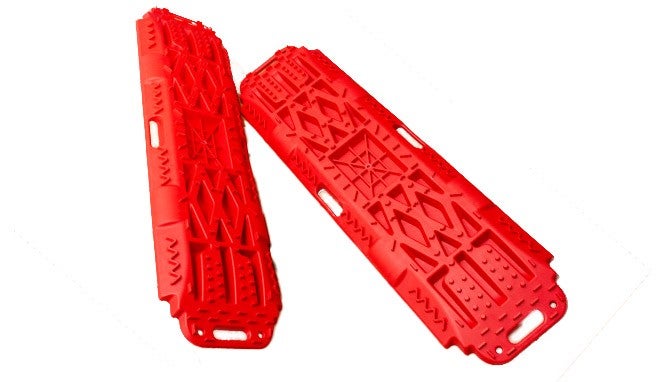
The traction boards from Bunker Industries are constructed from tough engineering-grade reinforced nylon for superior strength and durability yet remaining light weight for easy handling. They offer a wide footprint both length and width (47.6”x12.9”) with plenty of dimples, knobs, and any other pattern you can describe to provide traction to your tires. Additionally, these traction boards also have a molded section in the center of the boards for the shoe of your Hi-Lift jack to sit so you have a nice wide, secure base to use one in soft or sloppy conditions. The width of the Bunker Industries boards is something that we like, as with some of the other brands because they provide a wide footprint that allow for maximum traction when you’re running larger tires.
The traction boards also feature molded grab handles into each end and both sides so you can also use them as a shovel to help dig yourself out of a soft situation and to create room for placement of the boards. When you take the boards out of the packaging, be sure not to forget the set of two straps that you secure to them for easy recovery when you’re done.
Rescue Yourself With Instant Traction
To put the Bunker Industries traction boards to the test, I spent an afternoon at one of my favorite secret test areas in San Diego. With the heavy activity of inexperienced city drivers on soft sand launching their PWCs and boats, it’s not hard to find someplace to intentionally bury the rear end of my Jeep WJ. I intentionally had the rear end of the Jeep sunken into the loamy sand ensuring that I had no movement forward. I broke out the Bunker Industries traction boards and utilized the ability to use them as a shovel to dig out sand from the front of the tires. As a shovel they work ok, that’s not what they’re primarily intended for, but they do get the job done. Now that I had dug slightly under the tires and out front, I placed the traction boards as far as I could under the tire tread. This would allow the tire to slightly spin and drop down onto the leading edge of the traction board where it should get adequate bite to get me rolling.
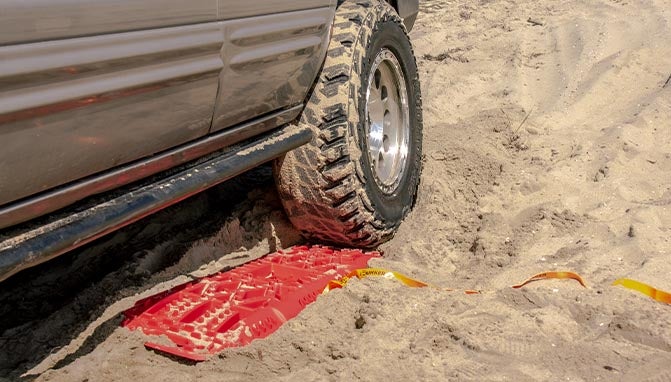
Boards in place, I jumped into the driver’s seat and started applying throttle while looking out of the window to ensure that the tires were biting onto the boards as intended. As I applied the throttle, the tires spun as anticipated and dropped onto the board where they spun a little more before biting onto the lugs of the boards, and getting the necessary traction to lift the rear end out of the hole and provide forward movement to get out of the chewed up sand. Once out, I picked up the boards utilizing the straps, gave them a good bang against the tires to knock off any sand that was sticking to them and threw them into the back of the Jeep. I’ll be looking into methods of attaching them to my roof rack soon to avoid tracking any excess sand or mud finding its way into the cargo area of the Jeep.
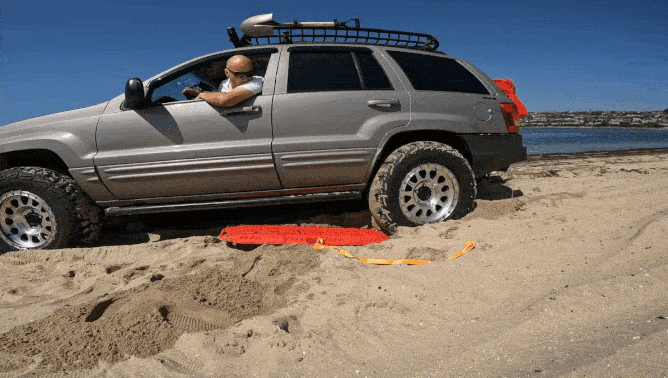
The Con's
As previously stated, lightweight materials are used to keep the traction boards light and easy to handle, but this also means that they’re susceptible to bending/flexing when not fully supported i.e. used for traction up a rock face where the majority of the board would not have anything underneath it. While I primarily off-road in sandy, desert style terrain I haven’t found this to be an issue. From reading other reviews, owners have stated that the boards did flex but returned to their original shape when done. What I did find was that when the tires spun before getting a bite on the lugs of the traction boards, the first row of lugs had broken off under the stress of the tires grabbing hold. If this continues to happen when you use these traction boards, you may find yourself needing to replace them sooner than later.
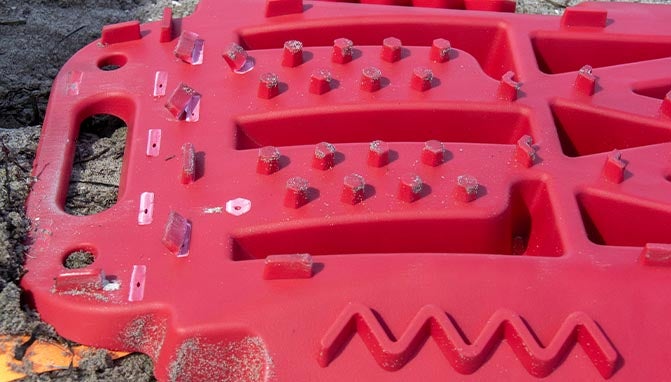
The only other negative feedback that I’ve been able to find with these traction boards is that they don’t come with any kind of carrying bag or mount kit. Most other brands will supply you with one of the two, they are also more expensive so therein lies some of the tradeoff. If you have a roof rack, you can easily find traction board mounting kits for a wide variety of applications from roof racks to hood mounts depending on the vehicle, or you can even get creative and try to make your own.
Final Thought
For the average off-roader, these traction boards are a solid investment for the price you pay. If you’re playing in extreme terrain (hard core rock crawling) you might want to invest in a set that are a bit heavier duty and less resistant to flex, but for the general trail guy or gal, these are a great asset to keep you out of trouble without the hassle of breaking out everything you need to use a winch (if you even have one).
What are traction boards?
Traction boards are long, flat pieces of heavy-duty plastic or nylon that you can use to place between the ground and your spinning tires when you’re stuck and need extra traction moving forward or backward to get your stuck vehicle rolling again. They have various designs and sizes to suit the needs of a wide range of drivers and terrain where used. Most have aggressive tread designs so your tires can achieve maximum traction and avoid tire spin.
Why do I need traction boards if I have a winch?
While a winch is the ultimate tool for self-recovery, not every situation requires such a complex method of getting unstuck. In a matter of minutes, you can remove traction boards from their carrying bag inside your rig or pull them from their hard mount location so you can place them under the tires. With a winch you need to find a suitable anchor point to winch from, dig out your controller, unspool your winch line, setup shackles and trunk savers, and then start pulling to get yourself unstuck. In short traction boards can be much more convenient and time saving versus using a winch.
How do you carry these on/in your rig?
Some brands come with a carrying bag that you can put the boards in and stow in the back compartment of your off-road rig. The downfall with this is that if you’re in wet, snowy, or muddy conditions, even in a bag that moisture and muck are sure to leak out at some point. Other brands may come with mounting hardware to use on a roof rack, but again you need a suitable roof rack. A quick google search will give you plenty of suggestions or you can even look here to see if any suit your fancy.
Additional Resources
- Best Tow and Recovery Straps
- Essential Tow Points for Proper Off-Road Recovery
- Best Winches and Why You Need One
Become an Off-Road insider. Get the latest news first by subscribing to our newsletter here.
We are committed to finding, researching, and recommending the best products. We earn commissions from purchases you make using the retail links in our product reviews. Learn more about how this works.
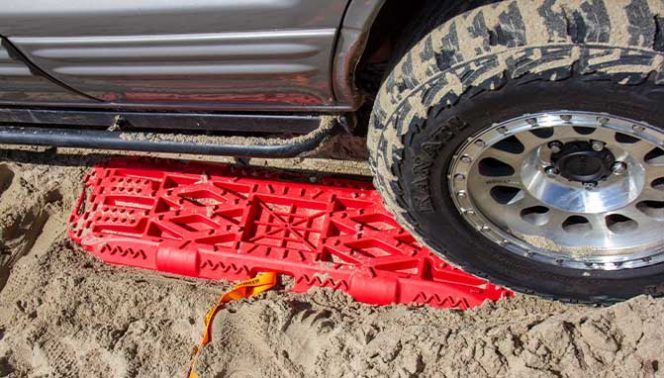
 Your Privacy Choices
Your Privacy Choices